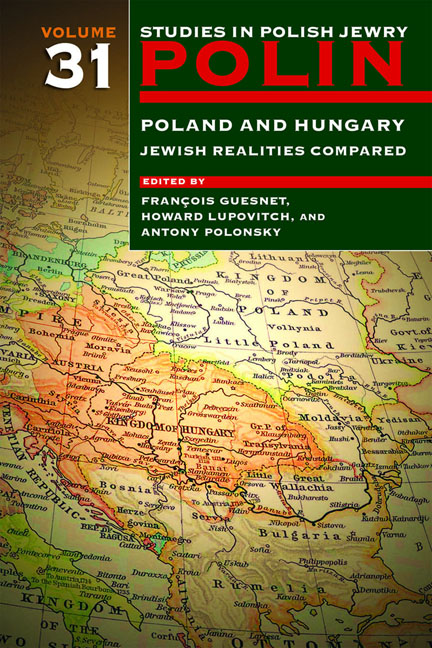Book contents
- Frontmatter
- Dedication
- Editors and Advisers
- Preface
- Polin
- Polin: Studies in Polish Jewry
- Contents
- Note on Place Names
- Note on Transliteration
- Part I POLAND AND HUNGARY: JEWISH REALITIES COMPARED
- JEWISH ACCULTURATION AND INTEGRATION
- JEWISH RELIGIOUS LIFE
- JEWS IN POPULAR CULTURE
- THE INTERWAR YEARS
- THE HOLOCAUST AND ITS AFTERMATH
- PERSONAL REFLECTIONS
- Part II NEW VIEWS
- Part III OBITUARIES
- Notes on the Contributors
- Index
The Politics of Exclusion: The Turbulent History of Hungarian and Polish Film, 1896–1945
- Frontmatter
- Dedication
- Editors and Advisers
- Preface
- Polin
- Polin: Studies in Polish Jewry
- Contents
- Note on Place Names
- Note on Transliteration
- Part I POLAND AND HUNGARY: JEWISH REALITIES COMPARED
- JEWISH ACCULTURATION AND INTEGRATION
- JEWISH RELIGIOUS LIFE
- JEWS IN POPULAR CULTURE
- THE INTERWAR YEARS
- THE HOLOCAUST AND ITS AFTERMATH
- PERSONAL REFLECTIONS
- Part II NEW VIEWS
- Part III OBITUARIES
- Notes on the Contributors
- Index
Summary
THIS CHAPTER seeks to present a comparative examination of the film industries in Hungary and Poland from the invention of the first motion picture cameras in the 1890s up to and including the Second World War, and the important role played in this industry by Jews from both countries. Throughout the period, Hungary had a vibrant film industry, yet, from the end of the First World War, each successive government tried to politicize and shape it. In Poland, government interference was less intrusive until the late 1930s, and Jews continued to play an important role in the film industry until the German invasion in September 1939. Nevertheless calls were made to limit the role of Jews. Even though the history of filmmaking in the two countries was very different, there still remain some interesting historical comparisons to be explored. In particular, this chapter will examine the Hungarian Theatre and Film Chamber (A Színművészeti és a Filmmuʺvészeti Kamara), established in 1938 by the regime of Miklós Horthy in order to limit the number of Jews working in the film business in Hungary.
It was during the interwar period that the power of propaganda through the medium of film was recognized and utilized by governments in Europe. In 1933 the Nazi government in Germany established the Reichskulturkammer (Reich Chamber of Culture), which included a chamber (a professional organization for regulating members of a specific profession) for film. In 1935 it went further, establishing an International Film Chamber, which twenty-two European nations joined, intended to co-ordinate European efforts under the leadership of Nazi Germany to counteract the influence of American films in Europe.
Jews were at the forefront of developing and building the technologies of film and photography. While art historians, critics, and film theorists have argued about why this occurred, the sheer numbers of Jews who were pioneers in the field of film and photography, especially in eastern Europe, was remarkable. Max Kozloff, an American critic and photographer, claims that the Jewish sensibility and talent in these fields stems from the ‘tension between alienation and its opposite, the sense of belonging’.
- Type
- Chapter
- Information
- Polin: Studies in Polish Jewry Volume 31Poland and Hungary: Jewish Realities Compared, pp. 289 - 312Publisher: Liverpool University PressPrint publication year: 2018



